Posts Tagged ‘anti-Semitism’
Monday, March 6th, 2017
| * * *
Six Weeks Under The Red Flag Being the thrilling experiences of a well known Hungarian lady during the revolution of 1918-1919
by Baroness T. B. de Kaszon
Published in 1920 in The Hague by W. P. van Stockum & Son
(free pdf-File, click here)
* * *
I am reproducing this facsimile as a reflection of the author’s social and political values of this period and in this location, but mainly as an example of her anti-Semitism (see pages 7/11/16/17/23/25/27/31/ 32/37/73); for the lady in question is the Baroness Margit Thyssen-Bornemisza de Kaszon, the wife of the German industrialist and banker, Heinrich Thyssen, and mother to their son ‘Heini’ Thyssen.
Originally the product of the union between the American Louise Price and the Hungarian Baron Gabor Bornemisza, she mysteriously adopted the name Gabriele in this book; her real name being Margit.
The title Baroness Thyssen-Bornemisza was the result of quite a remarkable piece of social engineering; her husband, having been adopted by her heirless father, acquired a Hungarian title, and purchased a castle and estate to go with it. (Originally called Rohoncz, as a result of the Treaty of Trianon it became part of Austria in 1920, renamed Rechnitz and remained in the ownership of the Thyssen family.)
Her daughter Margit married into the Batthyany family, who had originally owned Rechnitz castle, and it was this Margit who hosted the party in 1945 during which 180 Jews were murdered as after-dinner entertainment.
It was Margit Batthyany‘s great-nephew Sacha Batthyany who wrote the book ‘What’s That To Do With Me?‘ (english title: ‘A Crime in the Family‘), in which he also expressed his opinion of Jews and communists and adopted a similarly flexible, though less theatrical, attitude towards the truth; particularly concerning the Rechnitz massacre.
Many years later Margit Thyssen-Bornemisza’s other daughter ‘Gaby’ Bentinck (pictured on page 48, on the right) admitted to me that their escape from the castle in 1918/9 had involved nothing more dangerous than being driven to the station by their chauffeur, from where they caught a train to Vienna. |
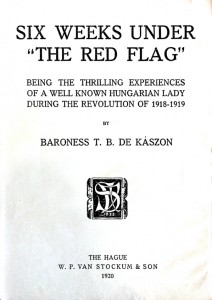 A self-indulgently fantastical, highly disturbing manifesto 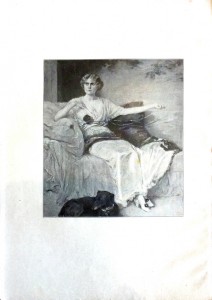 Margit Thyssen-Bornemisza nee Bornemisza, mother of Margit Batthyany nee Thyssen-Bornemisza, great-great-aunt by marriage of Sacha Batthyany |
Tags: 'Gaby' Bentinck, A Crime in the Family, anti-Semitism, Austria, Baron Gabor Bornemisza, Batthyany family, chauffeur, communists, Heini Thyssen, Heinrich Thyssen, Hungarian title, Jews, Louise Price, Margit Batthyany, Margit Thyssen-Bornemisza, Rechnitz, Rechnitz Castle, Rechnitz Massacre, Rohoncz, Sacha Batthyany, Six Weeks under the Red Flag, Thyssen Family, Treaty of Trianon, truth, Vienna, What's That To Do With Me
Posted in The Thyssen Art Macabre, Thyssen Family Comments Off on Sacha Batthyany’s Great-Aunt’s Mother Casts the Die in Hating Jews and Cursing Communists
Saturday, April 2nd, 2016
| UND WAS HAT DAS MIT MIR ZU TUN? or ‘What’s That To Do With Me?’ may or may not have literary merit. As far as I am concerned, the point is irrelevant. Sacha Batthyany is, in my considered opinion and by way of fair comment, an arrogant, self-obsessed, duplicitous, redundant Hungarian aristocrat, whose small book struggles to qualify as non-fiction, while his conflict of interest becomes ever more obvious.
I would have to admit to not feeling particularly charitable towards Sacha Batthyany as the result of his criticism of the accuracy of my writing, which he claims to have been the inspiration for his book. It is however noticeable that while I reveal my sources of information, he fails to do so, apart from making much of his reliance on both his grandmother’s diaries (which he mysteriously plans to destroy; after he has revealed their edited contents) and the diaries of one of his family’s Jewish victims.
But as well as admitting to owing Sacha Batthyany a debt of gratitude for confirming that the Rechnitz massacre did indeed take place and that his ‘Aunt’ Margit Batthyany (nee Thyssen-Bornemisza) was indeed involved, I do have to admit to his skill in achieving another, quite remarkable objective. By means of literary alchemy and without any formal qualifications (apart from a diploma in journalism) or reliance on academic research, Sacha Batthyany has turned his rigors of guilt into a burden of condemnation and vilification, that could well result in large sales, behind which he and many like him can hide their aforementioned guilt without the need to any longer rely on the somewhat tired excuse for their forefathers’ crimes as having only been the result of ‘obeying orders’.
Sacha Batthyany also manages to hide what comes close to being displays of anti-Semitism behind his stance on what he claims to be a Jewish involvement in the development of communism. His virulent anti-communism and spectacular demonization of Josef Stalin will find a sympathetic ear amongst those, including many English and Americans, who will agree that Stalin’s crimes against humanity were so much worse than those of Adolf Hitler. But his main bone of contention with the communists appears to be an insistence that they were responsible for the loss of the land, power and glory of the Batthyany family; forgetting to remind his readers that in the case of Rechnitz Castle (nee Batthyany Castle), they had in fact lost the same along with five thousand acres of land to more financially potent owners (and ultimately the Thyssens) well before 1906.
Sacha Batthyany’s coverage of the Rechnitz massacre in 1945 only forms a small part of his book; almost by way of a prologue. He favours the Austrian authorities’ version of events and repeats the familiar claim that the Jews were only killed to prevent the spread of typhoid, and in direct response to a telephone call received at Rechnitz castle from a higher order. He casts doubt over the presence of ‘Aunt’ Margit’s husband, Ivan Batthyany, on the fateful night. He also denies all the evidence given to him by the late Josef Hotwagner, the town’s historian. He repudiates our evidence, ignores the published results of the Russian investigation and accuses the people of Rechnitz of looting the castle rather than accepting the evidence that they were attempting to extinguish the blaze that the fleeing German soldiers had been responsible for starting in order to prevent the building’s use by the invading Red Army (part of the Nero Decree, the local implementation of which would have been the much more likely overall reason for said ‘telephone call’).
This same derogatory attitude towards the local residents of Rechnitz had also been voiced by Christine Batthyany back in 2007 in answer to questioning by the Jewish Chronicle. She denied any complicity in the massacre on the part of Margit Batthyany-Thyssen and claimed that conflicting reports had been ‘spread by resentful villagers’. In light of the fact that prior to the 20th century, the town and the surrounding estate had been a fiefdom, ruled over by the Batthyanys, who were to become, like the Thyssens, Nazi collaborators, it is perhaps understandable that some of the villagers might have lacked a relationship rich in warmth and brotherly love; though Sacha insists that the town’s people were ‘embarrassingly’ deferential to him.
Sacha Batthyany completes his coverage of the Rechnitz massacre with an unsupported claim that he was ‘certain’ that ‘Aunt’ Margit ‘had not been shooting…… She did not kill Jews, as the papers were writing. There is no evidence. There are no witnesses…’. Though of course he can’t be certain. I never claimed that she had personally shot any Jews but, as witnesses had reported her apparent pleasure in watching Jewish forced labourers, who had been kept in the cellars of the castle, being beaten and killed, and as she was trained in the use of fire-arms, it seemed highly likely.
So, having appeased the families’ (both Thyssen and Batthyany) conscience concerning the Rechnitz massacre, but displayed little in the way of apologetic concern for the deaths of one hundred and eighty Jews, or the fact that his branch of the family continued for many years to rely on the profits of the German war machine via ‘Aunt’ Margit, Sacha Batthyany then moved on to address his family’s other crimes against humanity in support of his self-obsessive search for absolution. He should perhaps be reminded that as a result of his great-aunt’s financial support and granting of a safehaven for Sacha’s branch of the family, Margit’s brother Heini Thyssen was of the opinion that they were little more than a bunch of ineffectual scroungers. This somewhat extreme opinion was possibly understandable if, as Heini claimed, one appreciates the fact that Margit’s husband ‘Ivy’ displayed his socially superior attitude towards the Thyssens by having an affair with Heini Thyssen’s first wife, Princess Theresa zu Lippe Bisterfeld Weissenfeld.
Finally, I was somewhat surprised that the beleaguered UBS bank, who admittedly need all the good press they can get, invested sponsorship in this book; as did an ominous Swiss entity called the Goethe Foundation. So far, none of the Thyssens or the Batthyanys (and in particular those branches of the family who did not succumb to a convenient dependency on Thyssen finance) have seen fit to make any statement concerning ‘What’s That To Do With Me?’; particularly in the form of thanking Sacha Batthyany for his presumably much appreciated reassurance concerning the Rechnitz massacre. We await further developments in this direction with interest. |
|
 Saint Sacha, replacing the conscience of the guilty with the suffering of the innocent (photo copyright: Maurice Haas) |
Tags: Absolution, Adolf Hitler, anti-communism, anti-Semitism, apologetic concern, Austrian authorities, Batthyany Castle, Batthyany family, burden, Christine Batthyany, condemnation, conflict of interest, crimes against humanity, demonization of Josef Stalin, diaries, diploma in journalism, fiefdom, fire-arms, forefathers' crimes, German soldiers, German war machine, Goethe Foundation, grandmother, guilt, Heini Thyssen, Hungarian aristocrat, Ivan Batthyany, Jewish Chronicle, Jewish forced labourers, Jewish involvement in the development of communism, Jewish victims, Josef Hotwagner, large sales, literary alchemy, looting, Margit Batthyany-Thyssen, Nazi collaborators, Nero Decree, non-fiction, obeying orders, people of Rechnitz, Princess Theresa zu Lippe Bisterfeld Weissenfeld, Rechnitz Castle, Rechnitz Massacre, Red Army, rigors of guilt, Sacha Batthyany, safehaven, sources of information, telephone call, Thyssen, typhoid, UBS Bank, Und was hat das mit mir zu tun, vilification, What's That To Do With Me
Posted in The Thyssen Art Macabre, Thyssen Corporate, Thyssen Family Comments Off on An admission of the Batthyany-Thyssens’ guilt – served through a revolving door
Tuesday, September 22nd, 2015
|
This book begins with the author expressing his „astonishment“ at the fact that the entrepreneurial, Nazi period history of the United Steelworks (Vereinigte Stahlwerke, VSt) – a conglomerate which included Thyssen works – has not so far been properly researched by academia. Obviously, the independent scholarly information contained in our book has not been considered worthy of acknowledgment, regardless of the fact that it was as a direct result of its publication that Dr Donges and his fellow academic authors have been commissioned and funded to rewrite the Thyssens’ history.
Not until half way through the 400-page tome does he finally acknowledge that VSt was massively involved in armaments manufacture, but that, instead of perceiving this adequately, academia until now has rather viewed VSt as a mere raw iron and raw steel producer – in stark contrast to the Krupp-concern.
While it is difficult to know how to react to such obviously manipulated claims, this reviewer wonders whether it might ever occur to Dr Donges that the dimensions of previous mis-representations are such that it takes minimal intelligence to conclude that they must have been the result of intent rather than accident.
Considering that by the onset of Hitler’s dictatorship, the Thyssens, together with the German state, controlled 72,5% of VSt, and VSt’s output was three times the size of that of its biggest competitor, it was always illogical that Alfried Krupp was sentenced to prison at the Nuremberg Trials while the Thyssens got off scot-free. But for many and various reasons, explained at length in our book, they did, and there the myth of their quasi-heroic immaculacy began to be established.
It is apparent that German academia and the German media were prepared to follow this myth instead of, as we did, questioning it. In their defense they might argue that they were not able to view certain archives and that this has hampered their research. But while the Thyssen-Bornemiszas’ files have indeed been unavailable to academia until recently, for the past 53 years of their existence the ThyssenKrupp archives – officially at least (the truth is another matter) – have not been subject to such restrictions.
When at some point around 2006/7 Georg Thyssen-Bornemisza created the Thyssen Industrial History Foundation and placed in it his father’s archives (which we had previously viewed in private, first in Madrid and later in Monte Carlo), he effectively placed them under the questionable curatorship of Prof. Manfred Rasch, head archivist of ThyssenKrupp AG, and even, it seems, in the same building as the ThyssenKrupp archives in Duisburg.
This move did the extraordinary thing of symbolically uniting the files of Fritz Thyssen’s side with those of Heinrich Thyssen-Bornemisza’s side of the family; a momentous act, since it was a crucial element of the Thyssen historical myth that the two sides always pretended to have nothing to do with one another, a myth that the first three books in this series are nonetheless still trying to propagate.
Upon closer inspection of the contents lists, however, curious internal restructurings of files appear to be going on in these two archives. There are important files, which we know used to be in the archives of ThyssenKrupp, such as, surprisingly, the estate of Wilhelm Roelen (main war-time manager of Heinrich Thyssen-Bornemisza) or, unsurprisingly, the estate of Robert Ellscheid (main lawyer of Fritz and Amélie Thyssen), and which are now said to be in the new Thyssen Industrial History Foundation archives.
But what is most noticeable from the footnotes is that time and time again, when reference is made to armaments in particular, the files in question tend to allegedly have been sourced in the archives of the newly created Thyssen Industrial History Foundation, rather than the archives of ThyssenKrupp AG, giving the impression of a possible damage limitation aspect in respect of this already ailing giant of German heavy industry.
In any case, one of the few major admissions made in this book is that Fritz Thyssen’s flight from Germany to Switzerland at the onset of World War Two might have had less to do with heroic opposition to Adolf Hitler and more with the fact that he had contravened foreign exchange regulations and committed tax evasion on a massive scale, as we first revealed (though they say nothing of the other reasons for his flight, including Hitler’s humiliating accusations of self-interest).
While presenting the actual figures of Fritz Thyssen’s misdemeanours, namely 31 million Reichsmark in evaded tax plus 17 million Reichsmark Reich Flight Tax, equalling a total of 48 million RM payable to the German State, Dr Donges quickly attenuates the claim by explaining that the denazification board of 1948 did not come to the conclusion that this had played a role in Fritz Thyssen’s flight. But what he fails to mention – although another author in the same series of books does – is how any genuine Aufarbeitung by these courts stalled once the Cold War began.
It is also noticeable that the author alleges the critical tax investigation into Fritz Thyssen’s affairs to have begun in the late 1920s, when in actual fact it had started almost immediately after the end of World War One.
The book manages to reveal that the retiring Joseph Thyssen branch of the dynasty (deriving from the brother of old August Thyssen) indirectly profited from the persecution of the Jews, as the Reich paid out their 54 million RM shares in VSt after Fritz Thyssen’s flight and the confiscation of his assets, by handing them shares previously owned by Jews and taken from them as part of the Jewish Assets Levy (Judenvermögensabgabe).
But it was Fritz Thyssen, whose anti-semitism was most overt, as he was prominently involved in forcing the Jewish members Paul Silverberg, Jakob Goldschmidt, Kurt Martin Hirschland, Henry Nathan, Georg Solmssen and Ottmar E Strauss to vacate their seats on the supervisory board of VSt in 1933/4. And no matter how often in this series they will try to tell us that Fritz Thyssen “gradually denazified himself” starting in 1934 and that his anti-Semitism was not of the vicious, murderous kind, we need to remember that forcing Jews out of their jobs was the first step in their disenfranchisement and on the road to the Holocaust.
When the Simon Hirschland Bank in Essen was „aryanised“ in 1938 by a banking consortium including Deutsche Bank and Essener National-Bank AG, Fritz Thyssen bought a share of 0.5 million RM, yet his role is said to be „unclear“ and „explained unsatisfactorily by reseachers“, which is the academics’ way of sowing doubt over established facts, especially when these are detrimental to the Thyssens’ image, and especially when they have been funded by Thyssen institutions to rewrite their history.
Of course generally the all important finance and banking side of things remains as much in the dark as it was at the time in question. Dr Donges mentions anonymous holdings in Holland, Switzerland and the USA; the Reich’s camouflaging of armaments financing through Metallurgische Forschungsanstalt; and Faminta AG of Glarus, Switzerland, which he alleges to have been a foreign vessel for Thyssen & Co. rather than for Fritz Thyssen personally. He leaves US bond creditors unnamed and states that „the role of the Finance Ministry within the Third Reich has not been sufficiently studied yet“.
And while on page 28 Dr Donges admits, albeit in the most superficial of ways, that after the death of the patriarch August Thyssen in 1926, Fritz Thyssen had to relinquish “part of the VSt shares” to his brother Heinrich, he does not tell us how long this stock [not just a few shares, but an initial 55 million RM, no less, and for which Fritz received shares in the family’s Dutch bank Bank voor Handel en Scheepvaart in Rotterdam in return, which was controlled by Heinrich] might have remained under Heinrich Thyssen-Bornemisza’s ownership and whether any of it was still in his possession at the time of the confiscation of Fritz’s fortune in 1939/40 (and if so, what happened to it after this date).
Instead the author concentrates on looking at the „use of political, legal and social options to further economic success….during the Nazi period“. He concludes that „entrepreneurial advantages were to be gained from the development of the armaments enterprises“ and that „although the freedom of action was hampered through many restrictions compared to the time of the Weimar Republic, the leadership of VSt could still pursue a long-term investment strategy.“
Thus this work ends with the earth-shattering conclusion that „if one looks at the development lines of the German steel industry in the 20th century, the long-term trend was that the steel manufacturers moved towards further processing. So VSt in the 1930s would probably have chosen that way even under another political regime“.
So presumably that was the main purpose of this book; to save the image of ThyssenKrupp AG and the conscience of surviving members of the Thyssen family, who have profited, and continue to do so, from the part Vereinigte Stahlwerke AG played in the death of 80 million people as a result of World War Two.
It is very difficult to see how Dr Donges’s doctoral thesis could possibly “close the gap” in research on the subject of the history of the United Steelworks during the Nazi period, as has been the claim made at the outset of this series “Family – Enterprise – Public. Thyssen in the 20th century”.
But whether anyone outside his immediate circle of overtly Thyssen-financed researchers will now wake up from their “great unquestioning slumber” and decide to pursue a more forthcoming research on the subject remains to be seen. Academic book reviews so far (by Tobias Birken at Sehepunkte and by Tim Schanetzky at H-Soz-Kult) suggest that they will not. In any case, how dissident academics would be received when knocking on the doors of “Professor Rasch’s archives”, remains an altogether different question. |
|
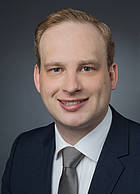 Political economist (Dr.) Alexander Donges, gaining his title by being a Thyssen academic mercenary at Mannheim University |
Tags: academia, Adolf Hitler, Alexander Donges, Alfried Krupp, Amelie Thyssen, anonymous holdings, anti-Semitism, armaments, armaments manufacture, aryanised, Aufarbeitung, August Thyssen, Bank voor Handel en Scheepvaart, banking consortium, Book review, camouflaging of armaments financing, Cold War, Concern Politics, denazification board, Deutsche Bank, dictatorship, disenfranchisement, dissident academics, doctoral thesis, Duisburg, entrepreneurial advantages, Essen, Essener National-Bank AG, Faminta AG, Finance Ministry, foreign exchange regulations, freedom of action, Fritz Thyssen, further processing, Georg Solmssen, Georg Thyssen-Bornemisza, German academia, German media, German steel industry, Germany, Glarus, H-Soz-Kult, Henry Nathan, Holland, Holocaust, Jakob Goldschmidt, Jewish Assets Levy, Joseph Thyssen, Judenvermögensabgabe, Krupp-concern, Kurt Martin Hirschland, long-term investment strategy, Madrid, Manfred Rasch, Market Economy, Metallurgische Forschungsanstalt, Monte Carlo, myth, Nuremberg Trials, Ottmar E Strauss, Paul Silverberg, persecution of the Jews, Reich Flight Tax, Robert Ellscheid, Rotterdam, Schöningh Verlag, Sehepunkte, self-interest, Simon Hirschland Bank, State Economy, supervisory board, Switzerland, tax evasion, tax investigation, The United Steelworks under National Socialism, Third Reich, Thyssen & Co, Thyssen in the 20th century, Thyssen Industrial History Foundation, ThyssenKrupp AG, ThyssenKrupp archives, Tim Schanetzky, Tobias Birken, United Steelworks, US bond creditors, USA, Vereinigte Stahlwerke, Weimar Republic, Wilhelm Roelen, World War One, World War Two
Posted in The Thyssen Art Macabre, Thyssen Corporate, Thyssen Family Comments Off on Book Review: Thyssen in the 20th century – Volume 1: „The United Steelworks under National Socialism, Concern Politics between Market Economy and State Economy“, by Alexander Donges, published by Schöningh Verlag, Germany, 2014.
Sunday, January 18th, 2015
| While both ThyssenKrupp and the Thyssen Bornemisza Group continue to pay academics and charitable foundations to rewrite their past, one member of the family has additionally been funding scholarship in order to buy an exalted academic identity for himself; with wealth polluted by the same tarnished history.
Lorne Thyssen-Bornemisza was born in Switzerland to the Scottish fashion model Fiona Campbell-Walter, who by the time of his birth was already separated from Lorne’s legal father, the Hungarian, Dutch, Swiss, German, Catholic, industrialist and art collector, Baron Hans Heinrich (Heini) Thyssen-Bornemisza; a man with his own identity problems, for whom Fiona had been his third wife.
As his second son, Lorne was also encouraged to adopt the ‘theatrical’ Austro-Hungarian title of ‘Baron’, despite the fact that in Switzerland (where waiters refer to him as ‘Mr Baron’), Austria and Hungary, the title has no legal status and Heini claimed his adopted son’s biological father was actually the American, Jewish, TV producer Sheldon Reynolds. But that didn’t stop Heini from accepting Lorne as a legal heir and supplying him with a dangerously generous allowance.
Lorne was educated at Le Rosey, a cosmopolitan, Swiss school that is perhaps better known for the wealth of its students’ parents than their off-springs’ academic achievement and from where he was expelled prior to completion of his International Baccalaureate studies. However, he did subsequently complete his basic Swiss Military Service while displaying less enthusiasm for gainful employment at the Thyssen Bornemisza Group´s corporate headquarters in Monaco.
Having adopted English as his first language, Lorne then established his colourful and extravagant social presence in London before endeavouring to read politics and philosophy at Edinburgh University. But as a result of the social distractions afforded him by his generous allowance, he failed to devote sufficient time to his studies and was obliged to abandon his academic ambitions.
He then moved to New York where he attended acting classes and even achieved some small measure of success in an off-Broadway Shakespeare play before moving on to Paris and from there to Beirut; where he acted in, and directed, a multi-million dollar, Thyssen-Bornemisza funded movie. He also adopted Muslim faith and became involved in Islamic mysticism, via the Sufi movement; whose funds he contributed to.
His generosity and the size of his inherited fortune were doubtless also instrumental in his being awarded a seat on the board of the Muslim Cogito Scholarship Foundation.
By now it must have begun to occur to Lorne that he could ‘procure’ academic status without the time-consuming inconvenience of having to study or take exams.
Heini had also taught him that cultural status could be obtained by the simple expedient of loaning out parts of his inherited art collection. A policy that would save on the cost of art storage and insurance.
So it was that he chose to loan his inherited collection of Muslim carpets to the Staatliche Museen zu Berlin; which resulted in a considerable enhancement of his standing amongst Germany’s cultural elite.
Considering the amount of time and effort that the Thyssen-Bornemiszas had invested in avoiding being considered German and denying their historic connections with the country, particularly during World War II, Berlin was, despite being the recognised centre of oriental carpet dealing, an extremely strange choice of location. Presumably it was an attempt to enhance his profile in Germany while his adopted family history was coming under academic scrutiny.
But given that Lorne wanted to achieve academic status in the UK, his choice of Oxford was logical, entirely predictable and possibly offered tax advantages to both parties. Given the Thyssens’ history of support for the Reich, use of industrial slave labour, involvement in violent anti-Semitism, profits from arms manufacturing in two World Wars, avoidance of reparations and retrieval of German assets by means of manipulated nationality and use of covert international banking, Lorne’s acceptance as an Honorary Fellow by the Wolfson College, Oxford University, in return for setting up the ‘Lorne Thyssen Research Fund for Ancient World Topics’, was nauseating; particularly as the College was originally founded and funded by Isaac Wolfson, a devout orthodox Jew and committed Zionist.
This was certainly not the first time that the Thyssens had used philanthropy to enhance their academic status while hiding the less palatable details of their past, which doubtless led to great aunt Amelie Thyssen’s creation of the Fritz Thyssen Foundation and aunt Gaby (Gabrielle Bentinck nee Thyssen-Bornemisza) giving money to Tel Aviv University via Lord George Weidenfeld, who developed a masterly skill in brokering such philanthropic deals. This process may also have encouraged Yad Vashem (Israel’s Holocaust Commemoration, Documentation, Research and Education Centre) to overlook the Thyssens´ involvement in the slaughter of one hundred and eighty Jewish slave workers as after dinner entertainment at their castle in Rechnitz, Burgenland, Austria, on 24./25.03.1945. For one of the unfortunate by-products of academic philanthropy is that in protecting their benefactors, seats of learning are often encouraged to participate in historical amnesia.
Subsequently, Lorne’s freshly-minted academic status may have awarded his recently opened Kallos Gallery in London’s Mayfair some additional degree of credibility in its sale of his ancient Greek artefacts; if only he had resisted having the temerity to announce that he had signed up to ‘read’ Classical Studies with the Open University (having first presented the OU with ‘two fully funded MA scholarships…made possible through the generosity of Baron Lorne Thyssen-Bornemisza. The scholarships will provide the full fees for two year part-time MA studentships in Classical Studies at the Open University’) presumably in an attempt to acquire some small measure of legitimate, academic achievement.
Though I doubt that professional image builders would have encouraged such a revelation, as it could only serve to demote his elevated status as a ‘Fellow’ and ‘Honorary Fellow’ elsewhere.
I admire the Open University and used to respect Oxford University as what I believe I should expect it to be; an incorruptible seat of learning. But I don’t admire or respect academic whoring. There is too much of it about and, in this case, it is in clear contradiction of the old Latin adage, ‘Pecunia non olet.’
https://www.wolfson.ox.ac.uk/person-type/honorary
https://www.wolfson.ox.ac.uk/clusters/ancient-world/lorne-thyssen-research-fund
http://www.open.ac.uk/Arts/classical-studies/baron-thyssen-ma-scholarship.shtml
(p.s.: Lorne Thyssen is also a Fellow of The Royal Numismatic Society. At its 2012 International Congress held at the Israel Museum in Jerusalem he acted as a chairperson with presentations given by members of Staatliche Museen Berlin, Tel Aviv University and Oxford University – thus closing the circle of – what we have the right to consider – duplicity). |
|
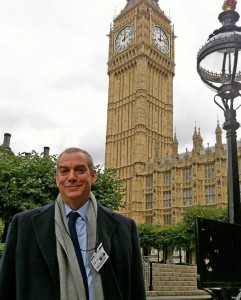 Lorne Thyssen-Bornemisza pretending to be British and clean (www.thyssenpetroleum.com). |
Tags: academia, academic philanthropy, academic status, Amelie Thyssen, anti-Semitism, Austria, avoidance of reparations, Baron Thyssen MA Scholarship, Beirut, Berlin, Broadway, Burgenland, charitable foundations, Classical Studies, Cogito Scholarship Foundation, covert international banking, Edinburgh University, Fiona Campbell-Walter, Fritz Thyssen Stiftung, Gabrielle Bentinck, Germany, Hans Heinrich Thyssen-Bornemisza, Holocaust, Holocaust Commemoration, Holocaust Documentation, Holocaust Education, Holocaust Research, Honorary Fellow, Hungary, international baccalaureate, international banking, Isaac Wolfson, islamic mysticism, Israel Museum, Jerusalem, Kallos Gallery, Le Rosey, London, Lord George Weidenfeld, Lorne Thyssen, Lorne Thyssen Research Fund for Ancient World Topics, Lorne Thyssen-Bornemisza, manipulated nationality, Mayfair, Monaco, Muslim carpets, Muslim faith, New York, Open University, oriental carpet dealing, orthodox Judaism, Oxford, Oxford University, Paris, pecunia non olet, philanthropy, Rechnitz, Rechnitz Massacre, retrieval of German assets, scholarship, Shakespeare, Sheldon Reynolds, slave labour, Staatliche Museen zu Berlin, Sufi movement, Swiss military service, Switzerland, Tel Aviv University, The Royal Numismatic Society, Thyssen Bornemisza Group, Thyssen Petroleum, ThyssenKrupp, Wolfson College, World War II, Yad Vashem, Zionism
Posted in The Thyssen Art Macabre, Thyssen Art, Thyssen Corporate, Thyssen Family Comments Off on Lorne Thyssen – Buying Scholarship or: ‘does money smell’?
Monday, May 3rd, 2010
| Quite why ThyssenKrupp have waited so long to authorise their archivist and historian, Manfred Rasch, to bring out a book of letters between August Thyssen and his son Heinrich, seems somewhat of a mystery. The two men have, after all, been dead for 84 and 63 years respectively. But the professor appears to confirm my belief that this is part of the corporate and family response to my book, by including a rather bizarre statement amongst the credits, which runs thus (page 10):
‘People who are less interested in historically substantiated studies with traceable references and who would rather form their opinions based on sex-and-crime journalism might be entertained by Litchfield, David: The Thyssen Art Macabre, London 2006 (German edition: Die Thyssen-Dynastie, Die Wahrheit hinter dem Mythos, Oberhausen 2008).’
I feel such a statement says more about Rasch than it does about me, and I appreciate the publicity it has afforded my book, including the increase in visits to this website, particularly from the Ruhr district. However, a recent critical review awarded Rasch’s book on Amazon by a reader in Munich might have been unlikely to have imbued him with a similar spirit of generosity:
‘Unfortunately, the title of this book is somewhat misleading, as of the 214 letters only 4 are by Heinrich Thyssen’s hand. It also does not limit the scope of its contents to the years 1919-1926 but includes furthermore a considerable amount of historical material on the history of the Thyssen family and its industries which has been written by Professor Manfred Rasch who is listed as editor of the book. As Professor Rasch is also the head of the archives at ThyssenKrupp, it makes it difficult to accept the impartiality of his views. The style of the book is academic and thus requires an overwhelming interest in the subject matter, as much is being taken up with supportive material in the form of bibliography, sources, commentaries etc.
One also gets the impression that this book, despite its size and the obvious complexity of the research, was in fact created in some haste, as on far too many occasions it sidesteps various historical issues by announcing that scientific research is still ongoing. But what I find even more surprising is the way Prof. Rasch deals with other authors, some of whom have published considerable research about the subject, for instance the Briton David R L Litchfield (‘The Thyssen Art Macabre’, in German: ‘Die Thyssen-Dynastie’), whose description of the murder of 180 Hungarian slave labourers during a party organised at Rechnitz Castle by Margit Thyssen-Bornemisza caused a big stir a few years ago. Prof. Rasch suggests that his readers should view Litchfield’s book as mere entertainment: just an alarming error of judgement or a worrying example of professional jealousy?
This is particularly disturbing in the light of the anti-Semitism in the Thyssen family (see letters dated 9.9.1919, 21.7.1923 and 30.7.1923) which the book presents to the interested public. All in all, however, this is a fascinating read which contains much material of interest to both amateur and professional historians’.
One certainly gets the impression that the corporation may now be trying somewhat too hard to paper over the cracks in their historiography. You may no longer be able to see the cracks but you can certainly see where they have been, which only serves to draw attention to the papering.
I was also particularly interested in the impression that ThyssenKrupp is now giving of having archives that are open to the public. This was certainly not the case when we were researching our book. In fact quite the opposite. However, Rasch still seems determined to believe that, having been denied access to his archives, we chose to create our book without documentary evidence. This is of course totally and completely inaccurate and an opinion that appears to have been based on his wishful thinking.
Apart from the fact that our book is most certainly based on fully documented evidence, Rasch, who is obviously holding me responsible for the cracks in his professional credibility, would perhaps have been better advised not to talk of ‘entertainment’ in connection with a family that was responsible for the financing and use of slave labour, in particular (but not exclusively) in the context of the Rechnitz massacre (which Rasch chooses to ignore, apart from providing a link to an Austrian website).
To assist Manfred Rasch with future editions of his book, I include in this post excerpts of documents confirming the Thyssens’ war-time financing of their SS-occupied castle in Rechnitz, documents which I can only assume he overlooked in his haste to publish his book. They concern meetings of Heinrich and his son Hans Heinrich Thyssen-Bornemisza (‘Heini’) with their managers Heinrich Lübke and Wilhelm Roelen on 22 August 1941 in Flims, on 9 November 1941 in Zurich and on 2 February 1944 in Davos and include details of the RM 400,000 loan from August Thyssen Bank Berlin to Rechnitz, yearly contributions of RM 30,000 for Margit Batthyany and RM 18,000 for the upkeep of the castle, as well as a notification that Thyssengas (then Thyssensche Gas- und Wasserwerke) was generally ‘looking after’ Rechnitz.
Scanned Document
Scanned Document-1
Scanned Document-2
(all excerpts of documents in this post are from the archives of David R L Litchfield and are to be reproduced with his permission only). |
 ThyssenKrupp's historian and archivist Prof. Manfred Rasch 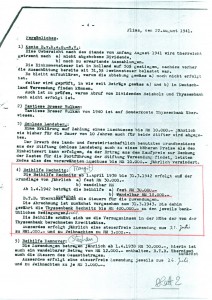 Documents substantiating Thyssen funding of Rechnitz castle during the second World War (Archives of David R L Litchfield, not to be reproduced without permission) 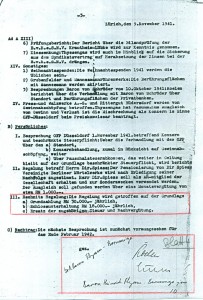 Documents substantiating Thyssen funding of Rechnitz castle during the second World War (Archives of David R L Litchfield, not to be reproduced without permission) 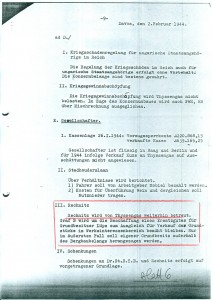 Documents substantiating Thyssen funding of Rechnitz castle during the second World War (Archives of David R L Litchfield, not to be reproduced without permission) |
|
Tags: Amazon, anti-Semitism, archives, August Thyssen, August Thyssen Bank, Berlin, bibliography, Davos, Flims, Heinrich Lübke, Heinrich Thyssen-Bornemisza, historiography, Manfred Rasch, Margit Batthyany, Rechnitz, Ruhr, slave labour, sources, Thyssengas, ThyssenKrupp, Thyssensche Gas- und Wasserwerke, Wilhelm Roelen, Zurich
Posted in The Thyssen Art Macabre, Thyssen Corporate, Thyssen Family Comments Off on What have ThyssenKrupp’s historians been doing all this time?
|










